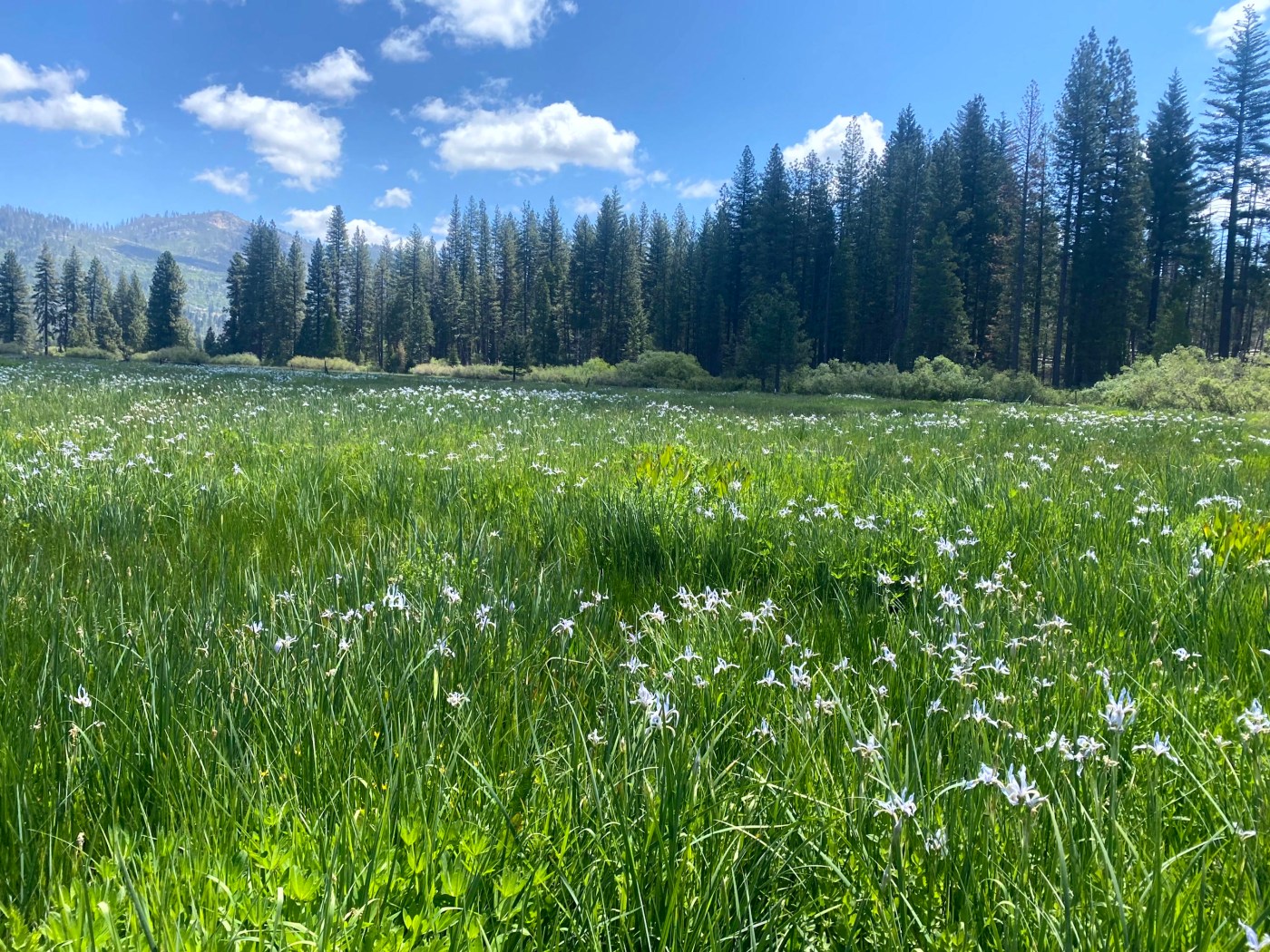Yosemite National Park is famous for towering waterfalls, giant sequoia trees and massive granite cliffs. But at an out-of-the-way spot near the park’s western boundary that few visitors ever see, a landmark of a different type is taking shape.
Workers are making progress this summer on an ambitious plan to turn a 400-acre property that was used for generations as a cattle pasture back into a healthy Sierra Nevada meadow.
The project at Ackerson Meadow, the largest wetlands restoration in Yosemite’s history, involves filling in massive amounts of erosion — including a 3-mile long gully that is 14 feet deep and 100 feet wide — with hundreds of truckloads of dirt and mulch, along with planting 425,000 native plants and more than 700 pounds of wildflower seeds.
The work, by crews overseen by Yosemite managers, began last year and is scheduled to finish next summer. The goal is to restore natural conditions not seen in the scenic meadow between Yosemite’s Big Oak Flat entrance station and Hetch Hetchy Reservoir since before the 1880s, when cattle grazing, logging, and homesteading began there.
“It’s an amazing location, with amazing resources. This meadow is a rare oasis in the Sierra,” said Frank Dean, president of the Yosemite Conservancy, a non-profit group based in San Francisco that is helping fund the $17.7 million restoration project. “It’s an incredibly rich place.”
Ackerson Meadow is home to great grey owls, black bears, and at least 55 species of birds, including the willow flycatcher. The property is closed to the public during construction but afterward is expected to be open again.
It was included in the original boundaries of the park in 1890, then removed a few years later when Congress made adjustments. Perched on the boundary of Yosemite and Stanislaus National Forest, it remained in private hands for more than a century.
The landscape, at about 4,600 feet elevation, had been coveted by developers for years as the site of a possible resort or other development.
In 2016, the Trust for Public Land, a non-profit group based in San Francisco, paid $2.3 million to purchase the property from Robin and Nancy Wainwright, members of a longtime ranching family in the area. The land trust donated the land to Yosemite, and it became the largest enlargement of the 750,000-acre park since 1949.
That year in an interview with the Associated Press, Robin Wainwright said his family had turned down a higher offer from developers who planned to build a resort there. He said the property bloomed with vibrant wildflowers in the spring, and he often saw bears wandering through the area and owls gliding overhead.
“To have that accessible by everyone to me is just a great thing,” he said. “It was worth losing a little bit of money for that.”
The transfer was not without controversy, however. It was opposed some ranchers and members of the Tuolumne County Board of Supervisors.
Shaun Crook, a board member of the Tuolumne County Farm Bureau, said in 2016 when Yosemite announced the deal that the property had been used for logging and to fatten beef cattle.
“That will no longer happen,” he said at the time. “I fear we’ll lose the value of that meadow.”
Yosemite’s meadows are home to hundreds of plants and animal species. Only 3% of Yosemite is in meadows, but they are the location of one-third of all of the plant species found in the park, according to the National Park Service. They are also a key source of water for the Bay Area, filtering snow melt, which eventually runs into rivers that provide water for San Francisco, the Peninsula, parts of San Jose and the East Bay.
“During the westward expansion of our country a lot of homesteaders and businesses looked at meadows like this as place to build and settle,” said Guillermo Rodriguez, California director of the Trust for Public Land.
“This meadow has been actively used for decades upon decades,” he said. “The water was diverted and channelized. The natural state was completely changed. The idea of the restoration work is to let nature get back to what it does well.”
Meadows act as sponges, soaking up water, and allowing plants, insects, birds, and other wildlife to flourish. Cattle grazing, dirt road building, logging and other activities over the years caused the soil to be compacted. That led to erosion, which carved the deep gullies. Those lowered the water table, drying out the property.
Crews have been filling the gullies with 150,000 cubic yards of dirt — about 15,000 dump trucks full — from nearby hillsides that burned in the 2013 Rim Fire. To form a mulch, they have been mixing the dirt with wood chips from firs, pines, and other trees that have grown overly thick in the nearby Merced Grove of giant sequoias, and been selectively removed to reduce fire risk.
“It’s a win-win,” Dean said.
Funding for the restoration project has come from donations from American Rivers, the Bonneville Environmental Foundation, California Department of Fish and Wildlife, the California Wildlife Conservation Board, Google, the National Park Foundation, the National Park Service, the U.S. Forest Service, and the Yosemite Conservancy.
“Ackerson Meadow is a regionally critical wildlife corridor that supports an amazing amount of biodiversity,” said Yosemite spokesman Scott Gediman. “The project truly exemplifies what can be achieved with a dedicated partnership.”
This undated photo provided by The Trust for Public Land shows Ackerson Meadow in Yosemite National Park, Calif. Visitors to the park now have more room to explore nature with the announcement on Wed. Sept. 7, 2016 that the park’s western boundary has expanded to include Ackerson Meadow, 400 acres of tree-covered Sierra Nevada foothills, grassland and a creek that flows into the Tuolumne River. This is the park’s biggest expansion in nearly 70 years, and will serve as wildlife habitat. (Robb Hirsch/The Trust for Public Land via AP)












